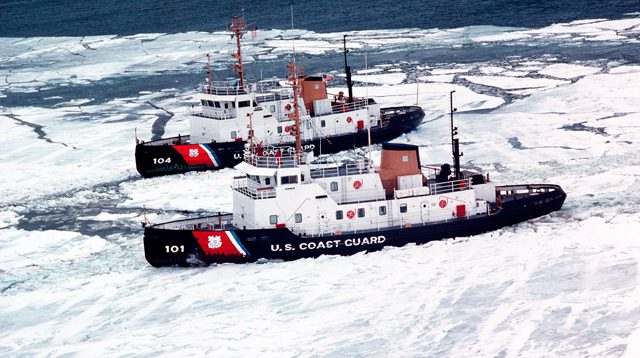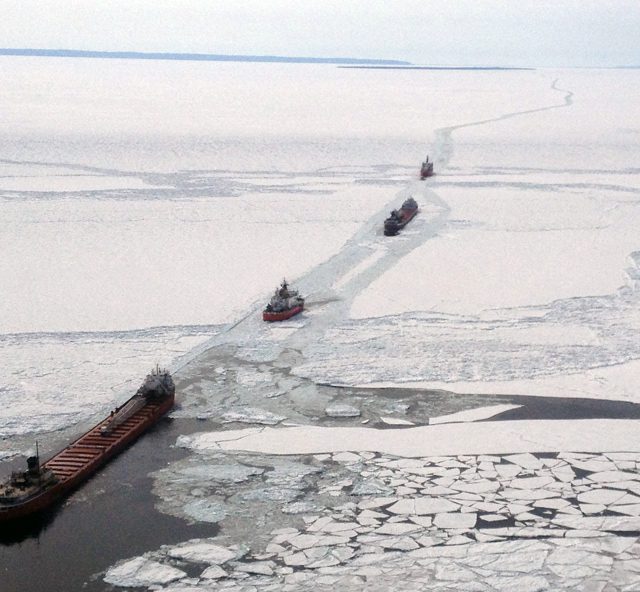Firms in Fed’s Beige Book Fret Over Any Lengthy Baltimore Port Closure
(Bloomberg) — The closure of one of the East Coast’s busiest ports after the collapse of Baltimore’s Francis Scott Key Bridge has so far not led to broad price increases,...


Straits of Mackinac (Apr. 6)–Coast Guard Cutter Katmai Bay (WTGB 101) and Biscayne Bay (WTGB 104) breaks ice in the Straits of Mackinaw on the Great Lakes. USCG photo by PA1 CAROLYN CIHELKA
The U.S. Coast Guard (USCG) reports today they have concluded Operation Taconite, the nation’s largest domestic ice operation which has enabled commercial shipping traffic to operate on the U.S. Great Lakes through one of the most brutal winters on record. Besides various liquid and dry cargoes, vast amounts of iron ore from the northern shores of Lake Superior were carried to the steel mills in Lake Erie and Lake Michigan while supported by Coast Guard icebreakers.
The Coast Guard notes that although official statistics have not been released, the 2013-14 winter season likely produced the thickest and most expansive ice cover the Great Lakes has experienced in 35 years.
During the 160 days of the operation, the USCG notes nine U.S. and three Canadian ice breakers spent more than 5,000 hours breaking ice for convoys and assisted in 946 commercial vessel transits that moved an estimated 33 million tons of cargo, valued at $1.2 billion. These commodities were crucial to sustaining industrial production and power generation for the Great Lakes region during the winter months.
Ice breakers provided direct assistance for 517 of the transits.
An additional 5,597 hours of ice breaking established and maintained tracks through the ice-choked waterways of Georgian Bay, Straits of Mackinac, Green Bay, southern Lake Michigan, St. Marys River, and across Lake Superior.


U.S. and Canadian Coast Guard aviators flew 43 sorties in direct support of the ice breaking operation, providing a bird’s-eye view of ice coverage, track quality and open water.
Ice breaking crews experienced the dramatic conditions first-hand. In February 2014, the crew of Coast Guard Cutter Katmai Bay spent eight days escorting the motor tanker Algocanada’s up the St. Marys River, a transit that takes 12 hours under historical ice conditions. The Katmai Bay’s crew had to stop the escort twice to refuel.
In March, the crew of Coast Guard Cutter Mackinaw, the Coast Guard’s most powerful icebreaker in the Great Lakes, led the tug Joyce L. Van Ekenvort with barge Great Lakes Trader on the season’s first westbound crossing of the Straits of Mackinac. The typically 12-hour voyage lasted four days. The Joyce L. Van Ekenvort is the most powerful tugboat on the Great Lakes.
The crew of Mackinaw also led the first eastbound crossing of Lake Superior. Their voyage lasted nine days, though it usually takes 24 hours.
The first load of iron ore, from Two Harbors, Minnesota to Gary Harbor, Indiana, took 13 days to deliver, which is normally a three day voyage.
Join the gCaptain Club for curated content, insider opinions, and vibrant community discussions.


Join the 105,953 members that receive our newsletter.
Have a news tip? Let us know.
Access exclusive insights, engage in vibrant discussions, and gain perspectives from our CEO.
Sign Up




Maritime and offshore news trusted by our 105,953 members delivered daily straight to your inbox.



Essential news coupled with the finest maritime content sourced from across the globe.
Sign Up